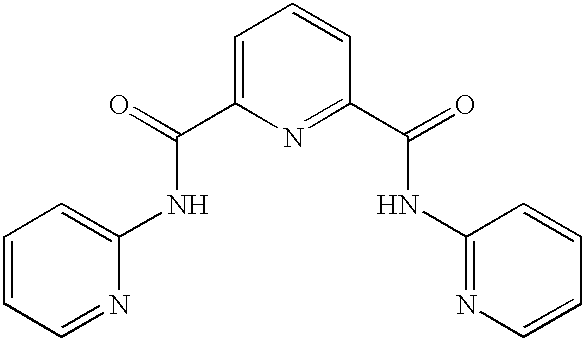Compositions and methods for hydration of terminal alkynes
a terminal alkyne and hydration technology, applied in the field of transition metal complexes, new organic ligands, can solve the problems of 168 years, difficult to handle existing enzymatic systems, and difficult to break half the amide bonds, and achieve the effect of facilitating one or more chemical reactions
- Summary
- Abstract
- Description
- Claims
- Application Information
AI Technical Summary
Benefits of technology
Problems solved by technology
Method used
Image
Examples
example 2
Preparation of cis-Dichloro-[(.eta..sup.2 -P,N)-3-(Diphenylophosphinomethyl)pyrazole]palladium(II) Having the Following Structure
##STR22##
To 3-(diphenylphosphinomethyl)pyrazole (0.124 g, 0.46 mmol) and bis(acetononitrile)palladium(II) dichloride (0.121 g, 0.46 mmol) is added degassed methanol (10 ml). The reaction slurry is stirred 14 hours at room temperature. The reaction slurry is filtered and the solid is washed with petroleum ether (2.times.10 ml). The solid residue is placed under vacuum to give pure cis-dichloro-(.eta..sup.2 -P,N)-3-[(diphenylphosphino-methyl)pyrazole]palladium(II) as a yellow solid in 93% yield (0.192 g, 0.43 mmol). Crystals for X-ray analysis are grown with the slow evaporation of methanol from a solution. This material is characterized as follows: .sup.1 H NMR (DMSO-d.sub.6, 200 MHz) .delta.12.90 (s, 1H), 7.88 (m, 5H), 7.60 (m, 6H), 6.54 (bs, 1H), 4.03 (d, J=13 Hz, 2H); .sup.13 C{.sup.1 H} NMR (DMSO-d.sub.6, 50 MHz) .delta.152.38 (d, J=6.5 Hz), 134.09, 133...
example 3
Preparation of 1-(Diphenylphosphinomethyl)pyrazole Having the Following Structure
##STR23##
Diphenylphosphine (2.642 g, 14.2 mmol) is placed into a Schlenk flask with degassed tetrahydrofuran (50 ml). The solution is cooled to -78.degree. C. and n-butyllithium (8.4 ml, 1.6 M in hexanes, 15.0 mmol) is added dropwise. The red solution is stirred at -78.degree. C. for an additional 1 hour then the cooling bath is removed and the solution is stirred for 3 hours. The red solution is cooled to 0.degree. C. and 1-(chloromethyl)pyrazole hydrochloride (0.698 g, 4.56 mmol) is added at once. The ice bath is removed and the reaction is stirred for 11 hours before adding degassed methanol (25 ml) and water (20 ml). The organic phase is separated and the aqueous phase is extracted with diethyl ether (3.times.10 ml). The organic phase is dried over magnesium sulfate, filtered and concentrated. The crude material is purified by chromatography (SiO.sub.2, 10% ethyl acetate / petroleum ether) to give 1-(...
example 4
Preparation of cis-Dichloro-[(.eta..sup.2 -P,N)-1-(Diphenylphosphinomethyl)pyrazole]palladium(II) Having the Following Structure
##STR24##
A flask is charged with 1-(diphenylphosphino-methyl)pyrazole (0.049 g, 0.184 mmol) and bis(acetonitrile)palladium(II) dichloride (0.048 g, 0.186 mmol). Degassed methanol (5 ml) is added. The resulting yellow solution instantaneously becomes cloudy. The slurry is stirred for 5 hours at room temperature then filtered through a glass frit. The precipitate is washed with dichloromethane then dried under vacuum (0.05 mmHg) giving cis-dichloro-[(.eta..sup.2 -P,N)-1-(diphenylphosphinomethyl)pyrazole]palladium(II) (0.068 g, 0.153 mmol) in 83% yield. This material is characterized as follows: .sup.1 H NMR (DMSO-d.sub.6, 200 MHz) .delta.8.24 (m, 1H), 8.09 (m, 1H), 8.00-7.80 (m, 4H), 7.75-7.40 (m, 6H), 6.61 (m, 1H), 5.47 (d, 8.2 Hz).
PUM
| Property | Measurement | Unit |
|---|---|---|
| pH | aaaaa | aaaaa |
| pKa | aaaaa | aaaaa |
| pKa | aaaaa | aaaaa |
Abstract
Description
Claims
Application Information
 Login to View More
Login to View More - R&D
- Intellectual Property
- Life Sciences
- Materials
- Tech Scout
- Unparalleled Data Quality
- Higher Quality Content
- 60% Fewer Hallucinations
Browse by: Latest US Patents, China's latest patents, Technical Efficacy Thesaurus, Application Domain, Technology Topic, Popular Technical Reports.
© 2025 PatSnap. All rights reserved.Legal|Privacy policy|Modern Slavery Act Transparency Statement|Sitemap|About US| Contact US: help@patsnap.com



